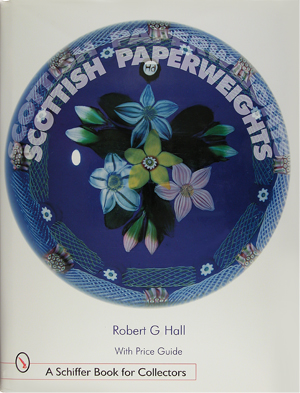Scottish Paperweights
by: Robert G. Hall
1999, Schiffer Publishing Ltd., Atglen, PA
172 pages, $49.95 hardbound.
flyleaf: “Paperweights have been made in Scotland from the early part of the 19th century with the first documented weights originating around 1835 from the Holyrood Flint Glass works in Edinburgh. This glassworks made paperweights with sulphide medallions depicting popular persons of the time. Sulphides were probably made until the end of the 19th century, but of the paperweights that have survived none include millefiori canes. From the early part of the 20th century, paperweights began to appear slowly at first but with increasing frequency, as small and large glassworks became involved in the production of decorative art glass.
This book shows a representative selection of paperweights from all known makers from 1835 to the present day. Millefiori first appeared in Scottish glass with the arrival of Salvador Ysart and his family in 1915. Originally from Spain, Salvador Ysart had learned the art of millefiori while working at a glassworks near Lyon and then Paris, France. After being recruited to the Scottish glass industry, he eventually settled for a career at John Moncrieff Glassworks in Perth. Salvador Ysart was joined in the workplace by his four sons, Paul, Antoine, Vincent and Augustine, and under their father’s tuition all the sons were to become skilled glassblowers.
The eldest son Paul also developed a passion for paperweights in the classic French style, and it was he who went on to introduce paperweights that were so good they were frequently mistaken for the finest French antiques. Paul’s influence on the Scottish glass industry was to become enormous, and many people who worked alongside him, during a career that spanned over sixty years, have gone on to start their own very successful glassworks, producing paperweights with a style and technique learned from this master paperweight maker.”

